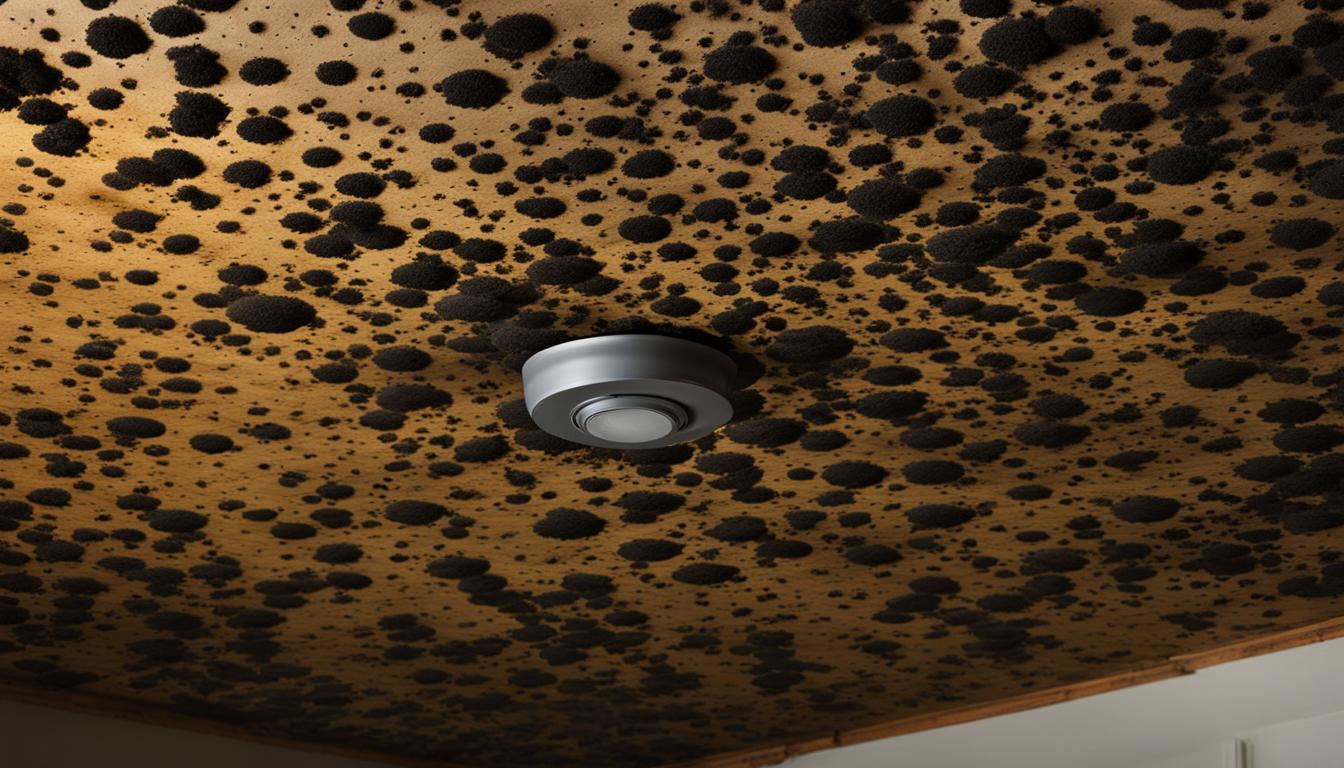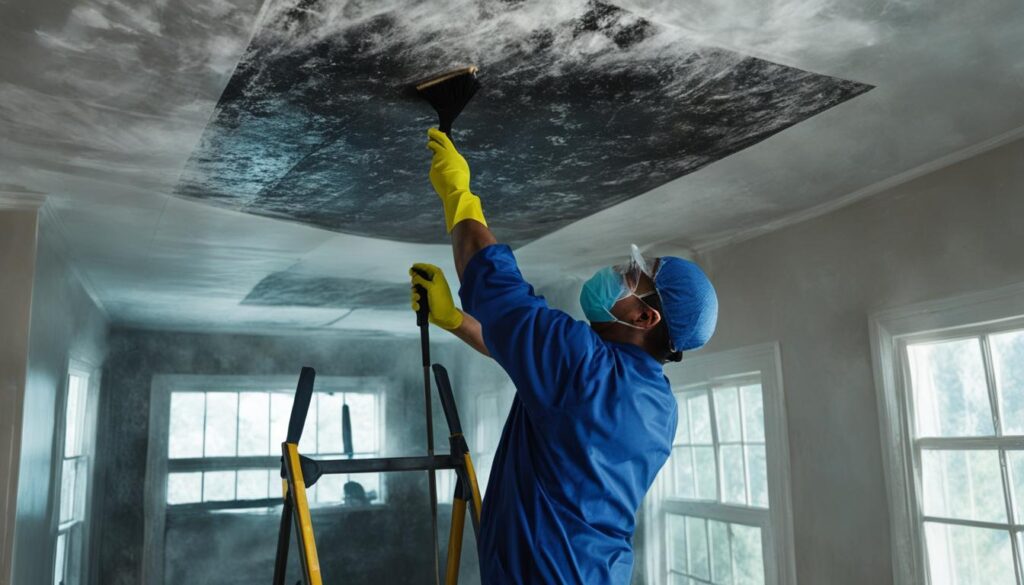
Black Mold on Ceiling: Causes and Removal Tips
Black mold on ceiling is a common problem that can pose severe health risks if left untreated. It is typically caused by moisture and poor ventilation, which create an ideal environment for mold growth. If you suspect that black mold may be present in your home, prompt action is necessary to prevent further contamination and ensure a healthy living environment. In this article, you will learn about the causes and potential health risks associated with black mold on ceilings, as well as effective removal tips and preventive measures to keep your home safe.
Key Takeaways:
- Black mold on ceiling is caused by moisture and poor ventilation.
- It poses potential health risks such as respiratory issues and allergic reactions.
- Prompt and proper removal is crucial to ensure a safe living environment.
- Preventive measures such as moisture control and regular maintenance can help prevent mold growth.
- Professional mold removal services may be necessary for severe cases of black mold on ceilings.
Understanding Black Mold Growth
Black mold on ceilings is often the result of underlying moisture problems. Mold spores thrive in damp areas, making humid and poorly ventilated spaces an ideal breeding ground. When the air is moist and stagnant, it creates the perfect conditions for mold growth on ceiling tiles, drywall, and even furniture.
The primary contributors to mold growth on ceilings include:
| Cause | Effects |
|---|---|
| High Humidity | Humidity above 60% provides mold with the moisture it needs to grow and spread rapidly. Water leaks, poor ventilation, and excess condensation can all contribute to high humidity levels. |
| Water Damage | Leaking pipes, roof leaks, and floods can create an environment where mold spores can thrive. Even small amounts of water can be enough to trigger black mold growth on ceilings. |
| Poor Ventilation | Without proper air circulation, damp air can become trapped and contribute to a moldy environment. Bathrooms, laundry rooms, and kitchens are especially susceptible to mold growth on ceilings due to high moisture levels and inadequate ventilation. |
To prevent mold growth on ceilings, it is essential to address any moisture issues promptly and maintain adequate ventilation
Health Risks of Black Mold on Ceiling
Black mold on ceilings should not be taken lightly due to the potential health risks it poses. Exposure to black mold spores can cause respiratory issues, such as wheezing, coughing, and nasal congestion. Individuals with pre-existing conditions like asthma or allergies are particularly vulnerable to these symptoms.
In addition, prolonged exposure to black mold may lead to more severe health problems, such as chronic lung illnesses and neurological issues. Toxic black mold, which is less common but more dangerous than regular black mold, can cause severe allergic reactions, headaches, and even death in extreme cases.
It is essential to take the necessary precautions to avoid these health risks and keep your living space safe. Seeking professional advice on black mold treatment and prevention is highly recommended.
Always wear appropriate protective gear, such as gloves and a face mask, when attempting to remove black mold from the ceiling. If the moldy area is too large or the damage is severe, it is advisable to seek assistance from professional black mold removal services.
<!–
“Don’t underestimate the health risks caused by black mold on the ceiling. It’s not just about the unsightly appearance, but the potential long-term effects.” – Dr. Amanda Smith
–>
In the next section, we will discuss the necessary steps to identify black mold on the ceiling accurately.
Identifying Black Mold on Ceiling
Black mold on ceiling is a health hazard that should be addressed promptly once detected. It is important to be able to identify black mold to prevent its growth and potential health risks. Here are some signs to look out for:
- Discoloration: Black mold on ceilings appears as dark spots or irregular patches that may differ in shade from the surrounding ceiling area.
- Musty odor: Black mold on ceiling emits a distinct, pungent odor that is often described as earthy or damp.
- Fuzzy or slimy patches: Black mold growth on ceiling presents itself as fuzzy or slimy patches, indicating the presence of mold colonies.
If you suspect the presence of black mold on ceiling, it is important to take action immediately to prevent further growth and protect your health. Contact a professional mold removal service or take appropriate safety precautions to carry out DIY removal.
DIY Black Mold Removal from Ceiling
Before starting the removal process, it is essential to take necessary safety precautions. Wear protective gear, including gloves, goggles, and a face mask to prevent the inhalation of mold spores. Ensure proper ventilation throughout the cleaning process.
The following are the steps for black mold removal from ceilings:
- Prepare a cleaning solution by mixing 1 cup of bleach with 1 gallon of water. You may also use a commercial mold cleaner instead of bleach solution.
- Apply the cleaning solution to the affected area using a spray bottle, or a cloth soaked in the solution. Ensure that all visible mold is covered with the solution.
- Allow the solution to sit on the affected area for 10-15 minutes to ensure that the mold is completely killed.
- Remove the mold using a scrub brush or sponge. Be careful not to damage the ceiling while scrubbing.
- Rinse the affected area with water and dry it thoroughly using a fan, dehumidifier, or natural air circulation.
Dispose of any cleaning supplies, rags, and protective gear used during the process. Remember to wash your hands thoroughly after the cleanup.
Regularly check for any potential mold growth on your ceiling and take action immediately if you notice any signs. DIY black mold removal is only recommended for small areas of mold growth; you should seek professional services for more severe cases.

Professional Black Mold Removal Services
While some cases of black mold on ceilings can be handled with do-it-yourself methods, more severe instances call for professional ceiling mold removal services. The expertise and specialized tools that professionals bring to the table can ensure that your home is completely free of mold.
Professional mold removal services can inspect your home for mold growth, identify the root cause, and then design a comprehensive plan to rid your home of black mold. They use advanced technologies to detect mold in hard-to-reach areas, such as within walls or air conditioning ducts, and employ specialized equipment to safely remove and dispose of mold spores.
Moreover, professional mold removal services use EPA-approved biocides and encapsulants to clean and treat the mold-infected areas. These treatments safeguard against any future mold growth and protect you and your family from the prolonged health risks associated with black mold on ceilings.
Avail yourself of the benefits of a safe and effective ceiling mold removal by hiring a certified mold remediation company.
Preventing Black Mold Growth on Ceiling
Prevention is key when it comes to fighting black mold on ceilings. Follow these best practices for effective and long-lasting ceiling mold prevention:
- Keep humidity levels in check: Use a dehumidifier to regulate the humidity levels in your home, especially in the bathroom and kitchen areas.
- Improve ventilation: Proper ventilation, especially in high-moisture areas, such as the bathroom and kitchen, helps to prevent the buildup of moisture and mildew.
- Repair leaks promptly: Fix any leaks in your roof, wall, or plumbing as soon as possible to prevent the buildup of excess moisture.
- Clean and disinfect: Regularly clean and disinfect surfaces, especially in high-moisture areas. Use a mold and mildew remover to keep potential growth at bay.
- Use mold-resistant products: Choose paint, drywall, and other building materials that are specifically designed to resist mold growth.
By following these tips, you can create a mold-free environment that promotes healthy living and prevents the need for expensive and time-consuming mold remediation.

Seeking Expert Mold Assessments and Prevention
If you suspect black mold growth on your ceiling, it is crucial to seek professional assistance for a comprehensive assessment. Fix Mold Miami is a leading provider of mold assessments, prevention, and remediation services in the Florida area.
Their team of experts conducts thorough inspections using state-of-the-art equipment to identify the extent of mold growth and potential sources of moisture. Based on their assessment, they develop a customized plan for remediation and prevention to ensure a mold-free environment.
Fix Mold Miami also focuses on preventative measures to avoid future mold growth, including proper ventilation, moisture control, and regular maintenance. With their expertise, they offer clients peace of mind and a safe living environment.
Don’t hesitate to contact Fix Mold Miami for professional mold assessment, prevention, and remediation services.
Conclusion
Black mold on ceilings is a serious concern that homeowners should not ignore. The risks to one’s health can be severe, and it is essential to take prompt action to remove and prevent mold growth. By identifying the root causes of mold growth and implementing preventive measures, you can protect your family from the potential health risks associated with black mold.
When it comes to mold removal, it is best to seek professional assistance, especially for severe cases. Fix Mold Miami is a trusted name in mold assessments, prevention, and remediation and can help you maintain a safe and healthy living environment. Contact us today to learn more about our services.
Remember, when it comes to black mold on ceilings, prevention is key. By staying vigilant and taking appropriate measures, you can keep your home free from mold and ensure that your family remains healthy and safe.
FAQ
What causes black mold to form on the ceiling?
Black mold on the ceiling is typically caused by excess moisture and poor ventilation. Leaks, high humidity levels, and condensation can create the ideal conditions for mold growth.
Are there any health risks associated with black mold on the ceiling?
Yes, black mold on the ceiling can pose health risks. Exposure to mold spores can lead to respiratory issues, allergic reactions, coughing, sneezing, and eye irritation. Individuals with asthma and allergies may be particularly susceptible to mold-related health problems.
How can I identify black mold on the ceiling?
Black mold on the ceiling is often characterized by dark black or greenish patches. It may appear fuzzy or slimy and can emit a musty odor. Discoloration and water stains are also common signs of mold growth.
Can I remove black mold from the ceiling on my own?
Yes, you can remove small patches of black mold from the ceiling on your own. However, it is important to take proper safety precautions, such as wearing protective clothing and masks. Additionally, it is recommended to consult professional remediation services for larger or more severe mold infestations.
How do I remove black mold from the ceiling?
To remove black mold from the ceiling, start by sealing off the affected area to prevent the spread of spores. Then, use a mixture of water and mild detergent to scrub the moldy surface. Rinse thoroughly and dry the area completely. If the mold persists or reoccurs, consider consulting professional mold removal services.
How can I prevent the growth of black mold on the ceiling?
Preventing black mold growth on the ceiling requires proper moisture control and ventilation. Fix any leaks promptly, maintain optimal humidity levels, and ensure good airflow in the room. Regularly inspect and clean your ceiling to identify and address any signs of mold growth early on.




